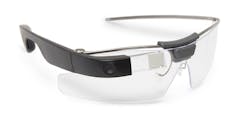Google Glass is back with its Glass Enterprise Edition (Fig. 1), albeit targeting industrial enterprise applications rather than the consumer. Google (aka Alphabet) pulled the earlier versions after a less-than-successful launch. Glass Enterprise has some hardware changes, but the targeting and support of its augmented reality (AR) platform is where major changes have occurred.
If you want to take advantage of Glass Enterprise you need to talk to a Glass Partner to get a cost estimate. Of course, your costs may vary. This a far cry from the original Glass exposure that was actively courting developers. We covered some of the Glass pioneers when Glass first came out, but Glass didn’t exactly take the world by storm.
The new, more focused approach keeps Google in the AR arena, which is already packed with quite a few hardware and software competitors. Virtual reality (VR) may get all the buzz these days, but AR is where practical solutions are emerging, and Google is following the money. A Forrester Research report predicts that more than 14 million U.S. workers will use smart glasses like Glass Enterprise by 2025.
In fact, Glass never went away—it just became unavailable to the general development community. The plethora of Glass Partners and solutions highlight the work that has been going on behind the scenes since the consumer orientation was tamped down in 2015. Glass Partners will be delivering complete hardware and software solutions rather than being distributors of either.
The hardware changes in Google Glass Enterprise (Fig. 2) including an 8 Mpixel camera with a red LED the glows when recording video (shades of “Battlestar Galactica” Cylons). The processor and wireless support has been upgraded to provide higher performance. It also uses less power, delivering longer battery life. An external power pack may be required if extensive multimedia streaming is needed. In general, the platform should provide a day’s worth of operational use.
The Glass Enterprise is designed around the “Glass Pod.” This more modular approach allows the platform to be used with prescription and safety glasses, including OSHA-certified safety shields.
Goggle has been rolling out many of its success stories, including AGCO, an agricultural equipment vendor. A $7 billion company that delivers heavy farm equipment, it already utilizes cutting-edge technology like autonomous robots for delivery of materials in its factories. The company found that Glass’ AR provided significant benefits compared to rugged tablets or laptops.
To utilize AR, a typical task was broken down into steps around five minutes in length. Verbal responses from the user could bring up help or pictures. More experienced users may simply complete steps without resorting to assistance. This helps for training but also provides experts with helpful reminders.
AGCO pad about $1,400 per Glass and has about 100 units in use, with plans for five times that many in the future. The AT tools are worth the money, given that they cut training time by more than two-thirds. It also improves ongoing operations.
Google’s results in the enterprise space match up with competitors in the AR space like Scope AR. The company’s WorkLink software works with a range of AR glasses, as well as smartphones and tablets providing a wider range of options than just Glass-oriented solutions.
Intel is also heavily invested in AR, in addition to mixed and virtual reality solutions. Intel has also been tying in their RealSense 3D sensing technology that provides interesting options for augmented reality software.
Google Glass isn’t the only platform on the market to use this form factor or to address the AR space, but it’s a lot like Intel, where being a large, major playing makes it easier to support large customers.
About the Author
William G. Wong
Senior Content Director - Electronic Design and Microwaves & RF
I am Editor of Electronic Design focusing on embedded, software, and systems. As Senior Content Director, I also manage Microwaves & RF and I work with a great team of editors to provide engineers, programmers, developers and technical managers with interesting and useful articles and videos on a regular basis. Check out our free newsletters to see the latest content.
You can send press releases for new products for possible coverage on the website. I am also interested in receiving contributed articles for publishing on our website. Use our template and send to me along with a signed release form.
Check out my blog, AltEmbedded on Electronic Design, as well as his latest articles on this site that are listed below.
You can visit my social media via these links:
- AltEmbedded on Electronic Design
- Bill Wong on Facebook
- @AltEmbedded on Twitter
- Bill Wong on LinkedIn
I earned a Bachelor of Electrical Engineering at the Georgia Institute of Technology and a Masters in Computer Science from Rutgers University. I still do a bit of programming using everything from C and C++ to Rust and Ada/SPARK. I do a bit of PHP programming for Drupal websites. I have posted a few Drupal modules.
I still get a hand on software and electronic hardware. Some of this can be found on our Kit Close-Up video series. You can also see me on many of our TechXchange Talk videos. I am interested in a range of projects from robotics to artificial intelligence.




